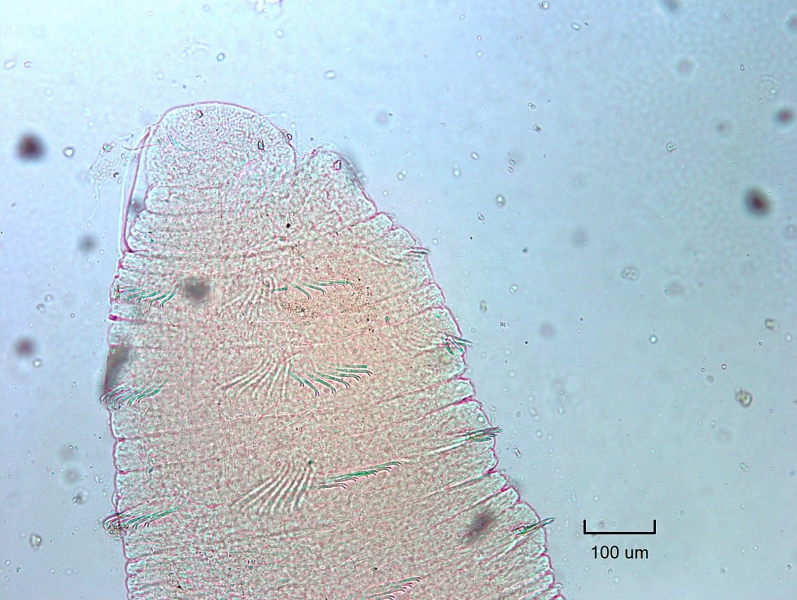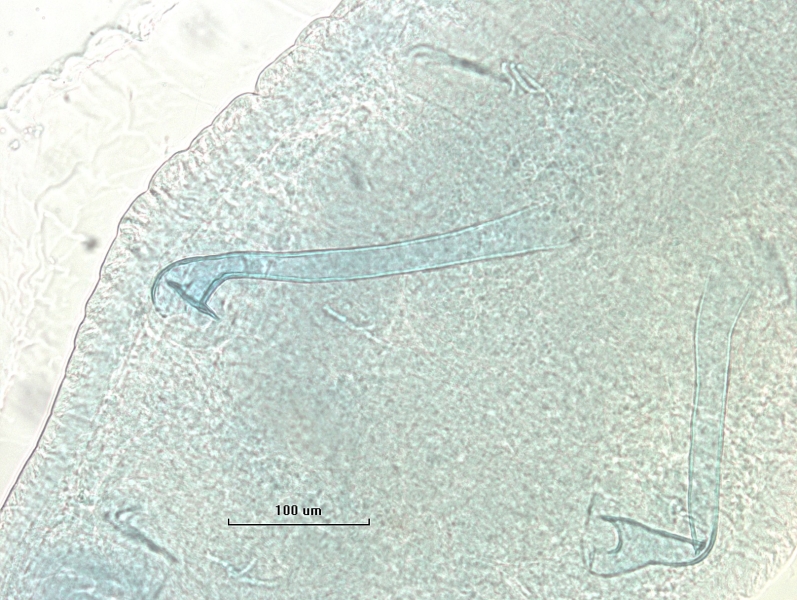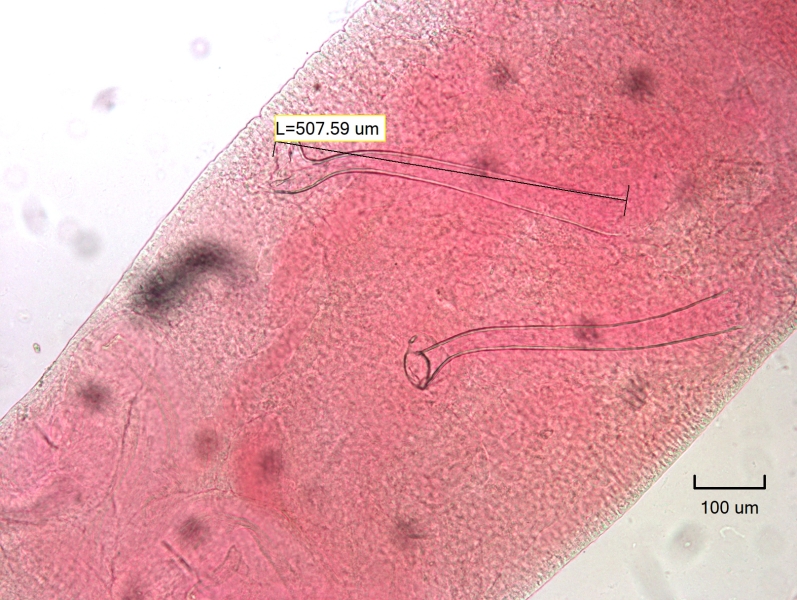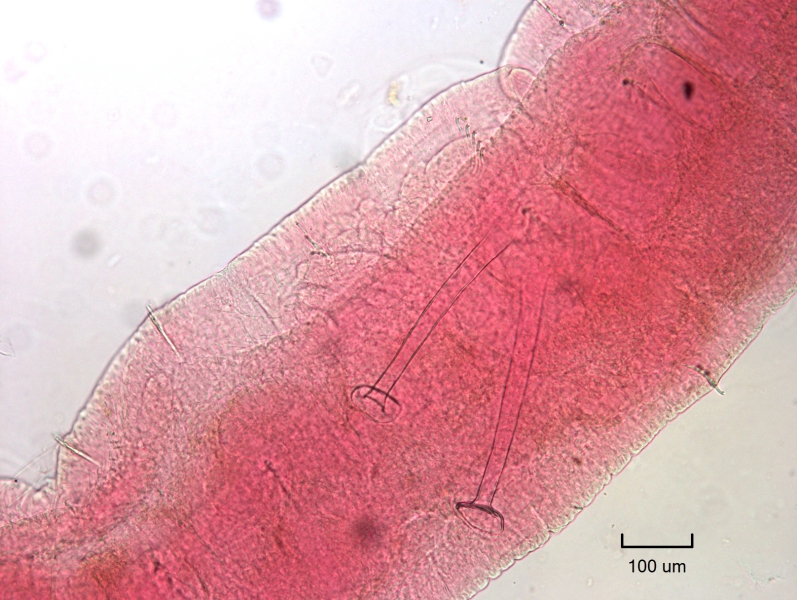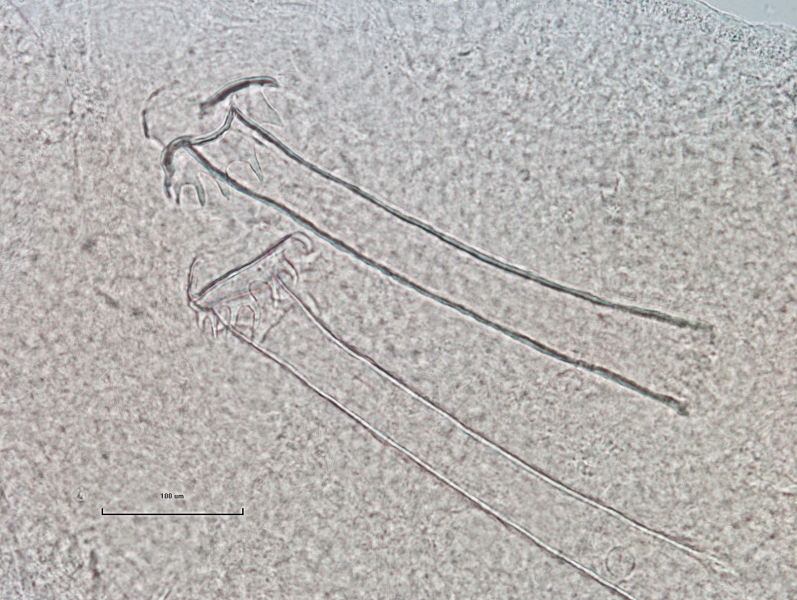Limnodrilus hoffmeisteri
Taxa description
Limnodrilus hoffmeisteri Claparède, 1862 is a freshwater oligochaete worm that is very common in the Great Lakes. It is a tubificid worm with bifid dorsal and ventral chaetae beginning in II and two cuticular penis sheaths in XI when mature. The anterior bundles have 3–7 (rarely up to 10) chaetae, with fewer in posterior bundles. It is common for Limnodrilus spp. to have variation in the chaetae, and the chaetae of Limnodrilus hoffmeisteri are somewhat variable, so the upper teeth may be a little shorter to a little longer and thinner than the lower. L. hoffmeisteri forma parvus has a very short and thin upper tooth in II–VI, gradually becoming subequal or even longer posteriorly; this form has been found in Ohio. The penis sheaths are usually 300–700 μm but may rarely be up to 1000 μm. The shaft may be cylindrical, or the basal third may be slightly flared but not conical. This species has more variability in the shape of the head of the penis sheath than other species of Limnodrilus: sometimes as a hood, sometimes at a right angle to the shaft, and sometimes with scalloped edges (L. hoffmeisteri var. spiralis and var. variant).
L. hoffmeisteri may be a complex of many cryptic species. In 1971, Brinkhurst and Jamieson revised the genus and placed over 40 synonyms within a single species, making L. hoffmeisteri the most common, most widely distributed tubificid in the world. A recent study (Liu et al. 2017) examined the genetic and morphological variation within a sample of L. hoffmeisteri from around the northern hemisphere and concluded that there is sufficient evidence for at least 10 cryptic species within the complex that cannot be separated by morphology alone.
Distinguishing features
L. hoffmeisteri is mainly identified by long penis sheaths, without which it will just appear as an immature tubificid worm without hairs. The penis sheaths are 300-700 μm long or longer with single-layered, thin walls, and a variety of head plate shapes and orientations (hood, flared, right angles to shaft, or scalloped margin). The chaetae are all bifid with the upper tooth a little shorter or a little longer and thinner than the lower tooth, and no hair chaetae.
Habitat
L. hoffmeisteri can be found in soft substrates and is very pollution tolerant so it may be found in pristine to highly enriched or polluted habitats. There is some variation in the penis sheath that may be linked to different habitat types with varying amounts of enrichment and pollution. L. hoffmeisteri var. spiralis is most often found in highly polluted areas.
Lake occurrence
This species occurs in all five Great Lakes.
Similar species
Without the presence of reproductive features, many tubificid worm species can only be identified as “immature tubificid with or without hair.” L. hoffmeisteri is the most common Limnodrilus species, but since there is a lot of variability in the size and shape of the penis sheaths, it has features that can overlap with many other species in the genus. This species is commonly confused with Limnodrilus profundicola because they have similar shaped penis sheaths and their sizes nearly overlap. The penis sheath of L. profundicola is usually less than 300 μm long, while L. hoffmeisteri is usually greater than 300 μm. Limnodrilus udekemianus could similarly be confused but its penis sheath is only up to 200 μm long and it also has unique anterior chaetae with the upper tooth longer and much thicker than the lower tooth, often bent at a right angle to the shaft of the chaetae. Sometimes the upper teeth of the anterior chaetae of L. hoffmeisteri are longer than the lower, but they are usually thinner than the lower tooth. On the upper end of its size range, L. hoffmeisteri could be confused with Limnodrilus claparedeianus. L. claparedeianus has penis sheaths that are usually 800–1100 μm long, up to 1300 μm. It can be distinguished because it is so long but also has a small, usually triangular head. L. hoffmeisteri has many different head plate shapes, but the closest might appear triangular but be composed of an overhanging hood and a broad lower lip. L. claparedeianus will be a flat triangle with no overhanging hood. Lastly, there is a chance that some specimens from other species with long penis sheaths may have underdeveloped penis sheaths falling within the 300–700 μm range. Pay close attention to the shape of the head plate and look carefully for thick or double-walled shafts. L. cervix should still have double-walled shafts and a head plate with triangular upper and lower lobes. L. maumeensis should still have thick walls and a large, broadly triangular head with a curved tip.
Another species with long penis sheaths and bifid chaetae is Varichaetadrilus angustipenis. The length is not noted in the keys, but it has long penis sheaths with small head plates usually perpendicular to the shaft, with the basal portion conical instead of cylindrical and sometimes crumpled. L. hoffmeisteri var. spiralis also has head plates perpendicular to the shaft, and other variations of L. hoffmeisteri may have a slightly flared basal third, but it will not be conical or crumpled. The other identifying factor of V. angustipenis is having chaetae in II with the upper tooth distinctly shorter and thinner than the lower. In L. hoffmeisteri, the chaetae of II vary from slightly shorter than the lower to a little longer but not distinctly shorter than the lower. The exception is L. hoffmeisteri forma parvus, which has the upper tooth shorter and thinner than the lower in II–VI, subequal upper tooth in the middle section, and posteriorly the upper tooth are thinner and equal to or slightly shorter than the lower. For comparison, V. angustipenis has distinctly shorter teeth in II, gradually becoming longer than the lower in IV–XI, and then subequal posteriorly. V. angustipenis is usually found in oligotrophic habitats, so it would not likely be found at an enriched site.
Relative size
L. hoffmeisteri is a relatively large freshwater oligochaete.
Does it have a barcode reference from the Great Lakes?
This species has a barcode reference from the Great Lakes.
References
Liu, Y., S.V. Fend, S. Martinsson, and C. Erséus. 2017. “Extensive cryptic diversity in the cosmopolitan sludge worm Limnodrilus hoffmeisteri (Clitellata, Naididae).” Organisms, Diversity, & Evolution 17:477–495.
Kathman, R.D., and R.O. Brinkhurst. 1998. Guide to Freshwater Oligochaetes of North America. pp. 156–157, 134, 154–162, 172–173.
Stimpson, K.S., D.J. Klemm, and J.K. Hiltunen. 1982. A Guide to the Freshwater Tubificidae (Annelida: Clitellata: Oligochaeta) of North America. pp. 36–39, 46–47.


